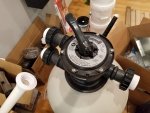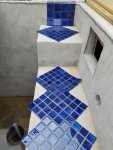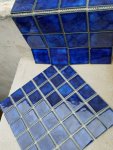I have been reviewing this forum for awhile, but first time posting. Hoping you guys can help with a few things.
For a number of reasons, I am going with a small plunge pool (or cocktail pool). Primary reason is space, second reason I am not a hot tub fan. So, I contacted a local concrete company and had them modify a precast storage/septic tank for me to accommodate pool plumping (skimmer, 2 returns, and a floor drain) and bonding wire. The tank is about 8 feet long, 5 feet wide, and 5 feet deep. It is already installed and about 2 feet is underground and about 3 feet above grade. I added concrete block steps at one end of the interior. My plan is to finish installing the plumbing, then waterproof, and then install tile.
Xypex:
Prior to tiling, I plan to apply a coating of Xypex Concentrate on the interior. My understanding is the tile should be applied within 48 hours of the xypex Concentrate application. As you can see from the attached photo's, the pre-cast company left the holes in the tank larger than needed, so I also purchased a bag of xypex add-mix (C-500) and plan to add to bags of cement that I will purchase at Home Depot.
Q: What type of thin-set to use?
Q: What is the ratio for the add-mix in this small, hand batching scenario?
Tile:
I have 2x2 and 3x3 porcelain tile (I live in DC, so have freeze cycles to consider). I plan to tile the interior with all tile. Edges will be with Schluter jolly white PVC trim. The pool will be 3x3 straight up and down, the steps 2x2 at a diagonal to try and distinguish the steps from the rest of pool. I will use Laticrete Spectraloc Pro Premium epoxy grout (Raven color). The waterfall wall will have 12x24 linen white tile (Laticrete Spectraloc Pro Premium epoxy grout- bright white). The cap of the wall will be 12x24 2" thermal cut bluestone.
Q: Should I use PVC trim on the steps as well?
Q: Should I use something other than Slate for the cap?
Set-up:
Q: How to by-pass the heater? I purchased 3 union/ball valves , but now wondering if I should use a diverter valve instead?
Q: What is the best way to connect the under the pool pipe, diverter or ball valve?
Q: What all needs to be bonded?
Pool Equipment:
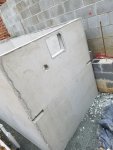
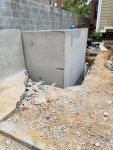
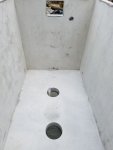
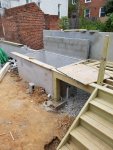
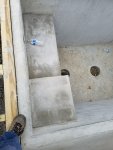
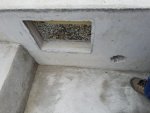
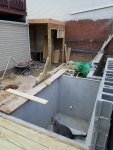

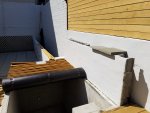
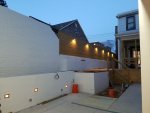










For a number of reasons, I am going with a small plunge pool (or cocktail pool). Primary reason is space, second reason I am not a hot tub fan. So, I contacted a local concrete company and had them modify a precast storage/septic tank for me to accommodate pool plumping (skimmer, 2 returns, and a floor drain) and bonding wire. The tank is about 8 feet long, 5 feet wide, and 5 feet deep. It is already installed and about 2 feet is underground and about 3 feet above grade. I added concrete block steps at one end of the interior. My plan is to finish installing the plumbing, then waterproof, and then install tile.
Xypex:
Prior to tiling, I plan to apply a coating of Xypex Concentrate on the interior. My understanding is the tile should be applied within 48 hours of the xypex Concentrate application. As you can see from the attached photo's, the pre-cast company left the holes in the tank larger than needed, so I also purchased a bag of xypex add-mix (C-500) and plan to add to bags of cement that I will purchase at Home Depot.
Q: What type of thin-set to use?
Q: What is the ratio for the add-mix in this small, hand batching scenario?
Tile:
I have 2x2 and 3x3 porcelain tile (I live in DC, so have freeze cycles to consider). I plan to tile the interior with all tile. Edges will be with Schluter jolly white PVC trim. The pool will be 3x3 straight up and down, the steps 2x2 at a diagonal to try and distinguish the steps from the rest of pool. I will use Laticrete Spectraloc Pro Premium epoxy grout (Raven color). The waterfall wall will have 12x24 linen white tile (Laticrete Spectraloc Pro Premium epoxy grout- bright white). The cap of the wall will be 12x24 2" thermal cut bluestone.
Q: Should I use PVC trim on the steps as well?
Q: Should I use something other than Slate for the cap?
Set-up:
- Suction: 1 skimmer and 1 floor drain. I have two holes at the bottom of the pool, one will be used as a main drain, the other will just be used to house the Hydro-static Relief Valve. I also have PVC pipes under the pool that will be connected to the pump, so that if water collects under the pool I have the ability to use my pump to remove it.
- Returns: 1 return at the steps, 1 return opposite side about 1.5 feet from the bottom, waterfall
- Equipment will be housed under deck. there is entry door next to stairs and from above via a trap door with hinges.
Q: How to by-pass the heater? I purchased 3 union/ball valves , but now wondering if I should use a diverter valve instead?
Q: What is the best way to connect the under the pool pipe, diverter or ball valve?
Q: What all needs to be bonded?
Pool Equipment:
- Hayward S180T1580S ProSeries 18-Inch 1 HP Sand Filter System
- Hayward WG1051AVPAK2 White 1-1/2-Inch Dual Suction Outlet for Concrete Pools
- HAYWARD POOL PRODUCTS SP1070SFVA Skim-Master Skimmer Skt with Float Valve for Pools, 1.5-Inch
- Hayward CSPAXI11 11 Kilowatt Electric Spa Heater
- Hayward SP1056 Hydrostatic Relief Valve
- Hayward SP1055 Relief Valve Suction Outlet Collector Tube
- Hayward CL100 Automatic Chlorine Feeder
- Hayward Sheer 500 Waterfall WFS524R6
- Pentair 263037 3-Way PVC 1-1/2 inch (2 inch slip outside) Pool And Spa Diverter Valve
- Hayward SP1022S Receptacles Vacuum Fittings for Concrete Pool
- Flo-Controls 1720C15 True Union Swing Check Valve, 1.5in., Clear
- Hayward QTA1015CSEG 1-1/2-Inch Gray QTA Series True Union PVC Compact Ball Valves




















Last edited:





